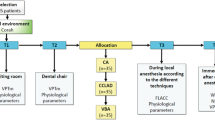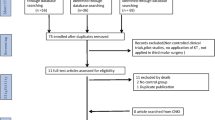Abstract
Purpose
To compare the Tell-Show-Do Technique (TSD-T) with Hiding Dental-Needle Technique (HDN-T) based on children’s anxiety, pain, and behavior during first-time mandibular block anesthesia.
Methods
A total of 52 children aged 3–5 years who had never received dental anesthesia and had at least one mandibular primary molar requiring extraction or pulpal therapy were included in the study. Children were randomly allocated into two groups: G1: TSD-T (n = 26) and G2: HDN-T (n = 26). This study included two sessions: intervention session (baseline) and control session (7 days after intervention). Facial Image Scale and Wong–Baker Pain Scale were used to evaluate anxiety and pain levels, respectively. Frankl Behavior Scale was used to assess children’s behavior.
Results
Anxiety and pain levels were not statistically significant between G1 and G2 groups (p > 0.05). Similar results were observed for children’s behavior rating (p > 0.05). Higher pain level was associated with younger children (rate ratios (RR) = 0.41; p = 0.016) and negative behavior (RR = 1.11; p < 0.001). On the other hand, in within-groups comparisons, there was a statistical difference in anxiety levels between intervention session and control session (p = 0.032) in G2.
Conclusions
Even though there are no differences in the efficacy of TSD-T compared to HDN-T during first-time mandibular block anesthesia in preschool children in terms of children’s anxiety, pain, and behavior, children from the HDN-T group can show reduced dental anxiety levels in the control sessions.

Similar content being viewed by others
References
Abanto J, Vidigal EA, Carvalho TS, Sá SN, Bönecker M. Factors for determining dental anxiety in preschool children with severe dental caries. Braz Oral Res. 2017;31:e13.
Addleston HK. Child patient training. Fort Rev Chicago Dent Soc. 1959;38:7–9.
American Academy of Pediatric Dentistry. Use of local anesthesia for pediatric dental patients. The reference manual of pediatric dentistry. Chicago: American Academy of Pediatric Dentistry; 2020. p. 318–23.
American Academy on Pediatric Dentistry Council on Clinical Affairs. Guideline on appropriate use of local anesthesia for pediatric dental patients. Pediatr Dent. 2008;30:134–9.
Ashley PF, Chaudhary M, Lourenço-Matharu L. Sedation of children undergoing dental treatment. Cochrane Database Syst Rev. 2018;12:CD003877.
Buchanan H, Niven N. Validation of facial image scale to assess child dental anxiety. Int J Paediatr Dent. 2002;12:47–52.
Davies EB, Buchanan H. An exploratory study investigating children’s perceptions of dental behavioural management techniques. Int J Paediatr Dent. 2013;23:297–309.
Davoudi A, Rismanchian M, Akhavan A, Nosouhian S, Bajoghli F, Haghighat A, Arbabzadeh F, Samimi P, Fiez A, Shadmehr E, Tabari K, Jahadi S. A brief review on the efficacy of different possible and nonpharmacological techniques in eliminating discomfort of local anesthesia injection during dental procedures. Anesth Essays Res. 2016;10:13–6.
De Menezes Abreu DM, Leal SC, Mulder J, Frencken JE. Dental anxiety in 6-7-year-old children treated in accordance with conventional restorative treatment, ART and ultra-conservative treatment protocols. Acta Odontol Scand. 2011;69:410–6.
Farhat-McHayleh N, Harfouche A, Souaid P. Techniques for managing behaviour in pediatric dentistry: comparative study of live modelling and tell-show-do based on children’s heart rates during treatment. J Can Dent Assoc. 2009;75:283.
Frankl S, Shire R, Fogels H. Should the parent remain with the child in the dental operatory? J Dent Child. 1962;29:150–63.
Fukayama H, Yagiela J. Monitoring of vital signs during dental care. Int Dent J. 2006;56:102–8.
Gazal G, Tola AW, Fareed WM, Alnazzawi AA, Zafar MS. A randomized control trial comparing the visual and verbal communication methods for reducing fear and anxiety during tooth extraction. Saudi Dent J. 2016;28:80–5.
Gillum RF. Resting pulse rate of children aged 1–5 years. J Natl Med Assoc. 1991;83:153–8.
Kamavaram Ellore VP, Mohammed M, Taranath M, Ramagoni NK, Kumar V, Gunjalli G. Children and Parent’s attitude and Preferences of Dentist’s Attire in Pediatric Dental Practice. Int J Clin Pediatr Dent. 2015;8:102-1–7.
Kantaputra PN, Chiewcharnvalijikit K, Wairatpanich K, Malikaew P, Aramrattana A. Children’s attitudes towards behaviour management techniques used by dentists. J Dent Child. 2007;74:4–9.
Klingberg G, Broberg AG. Dental fear/anxiety and dental behaviour management problems in children and adolescents: a review of prevalence and concomitant psychological factors. Int J Paediatr Dent. 2007;17:391–406.
Klingberg G, Ridell K, Brogårdh-Roth S, Vall M, Berlin H. Local analgesia in paediatric dentistry: a systematic review of techniques and pharmacologic agents. Eur Arch Paediatr Dent. 2017;18:323–9.
Kuscu OO, Akyuz S. Is it the injection device or the anxiety experienced that causes pain during dental local anesthesia? Int J Paediatr Dent. 2008;18:139–45.
Lin CS, Wu SY, Yi CA. Association between anxiety and pain in dental treatment: a systematic review and meta-analysis. J Dent Res. 2017;96:153–62.
Paryab M, Arab Z. The effect of Filmed modeling on the anxious and cooperative behavior of 4–6 years old children during dental treatment: a randomized clinical trial study. Dent Res J (Isfahan). 2014;11:502–7.
Peretz B, Efrat J. Dental anxiety among young adolescent patients in Israel. Int J Paediatr Dent. 2000;10:126–32.
Peretz B, Gluck G. Magic trick: a behavioural strategy for the management of strong-willed children. Int J Paediatr Dent. 2005;15:429–36.
Ram D, Peretz B. Reactions of children to maxillary infiltration and mandibular block injections. Pediatr Dent. 2001;23:343–6.
Ram D, Peretz B. The assessment of pain sensation during local anesthesia using a computerized local anesthesia (Wand) and a conventional syringe. J Dent Child (Chic). 2003;70:130–3.
Ramos-Jorge ML, Marques LS, Pavia SM, Serra-Negra JM, Pordeus IA. Predictive factors for child behaviour in the dental environment. Eur Arch Paediatr Dent. 2006;7:253–7.
Tirupathi SP, Rajasekhar S. Can single buccal infiltration with 4% articaine induce sufficient analgesia for the extraction of primary molars in children: a systematic literature review. J Dent Anesth Pain Med. 2020;20:179–86.
Wang SM, Kulkarni L, Dolev J, Kain ZN. Music and preoperative anxiety: a randomized, controled study. Anesth Analg. 2002;94:1489–94.
Wong DL, Baker CM. Pain in children: comparison of assessment scales. Pediatr Nurs. 1988;14:9–17.
Yassen GH. Evaluation of mandibular infiltration versus mandibular block anaesthesia in treating primary canines in children. Int J Paediatr Dent. 2010;20:43–9.
Zhang C, Qin D, Shen L, Ji P, Wang J. Does audiovisual distraction reduce dental anxiety in children under local anesthesia? A systematic review and meta-analysis. Oral Dis. 2019;25:416–24.
Funding
This study was funded by the Conselho Nacional de Desenvolvimento Científico e Tecnológico (CNPq—processo 141118/2013-0).
Author information
Authors and Affiliations
Contributions
EAV—design of the work, acquisition data for the work, drafting the work, final approval of the version to be published. JA—design of the work, analysis and interpretation of data for the work, drafting the work, revising the manuscript critically for important intellectual content, final approval of the version to be published. AMLM—design of the work, revising the manuscript critically for important content. GOB—acquisition data for the work. IEVA—acquisition data for the work. MSNPC—design of the work, revising the manuscript critically for important content. MB—substantial contributions to the conception and design of the work, final approval of the version to be published.
Corresponding author
Ethics declarations
Conflict of interest
The authors declare that they have no conflict of interest related to this study.
Ethics approval
Approval was obtained from the Ethics Committee of University of Sao Paulo, Brazil (CEP #1.167.940). The procedures used in this study adhere to the tenets of Declaration of Helsinki. Trial Registration: ClinicalTrials.gov Identifier: NCT02578160, ‘retrospectively registered’.
Consent to participate
Written informed consent was obtained from the children’s parents.
Additional information
Publisher's Note
Springer Nature remains neutral with regard to jurisdictional claims in published maps and institutional affiliations.
Rights and permissions
About this article
Cite this article
Vidigal, E.A., Abanto, J., Leyda, A.M. et al. Comparison of two behavior management techniques used during mandibular block anesthesia among preschool children: a randomized clinical trial. Eur Arch Paediatr Dent 22, 773–781 (2021). https://doi.org/10.1007/s40368-021-00617-2
Received:
Accepted:
Published:
Issue Date:
DOI: https://doi.org/10.1007/s40368-021-00617-2




